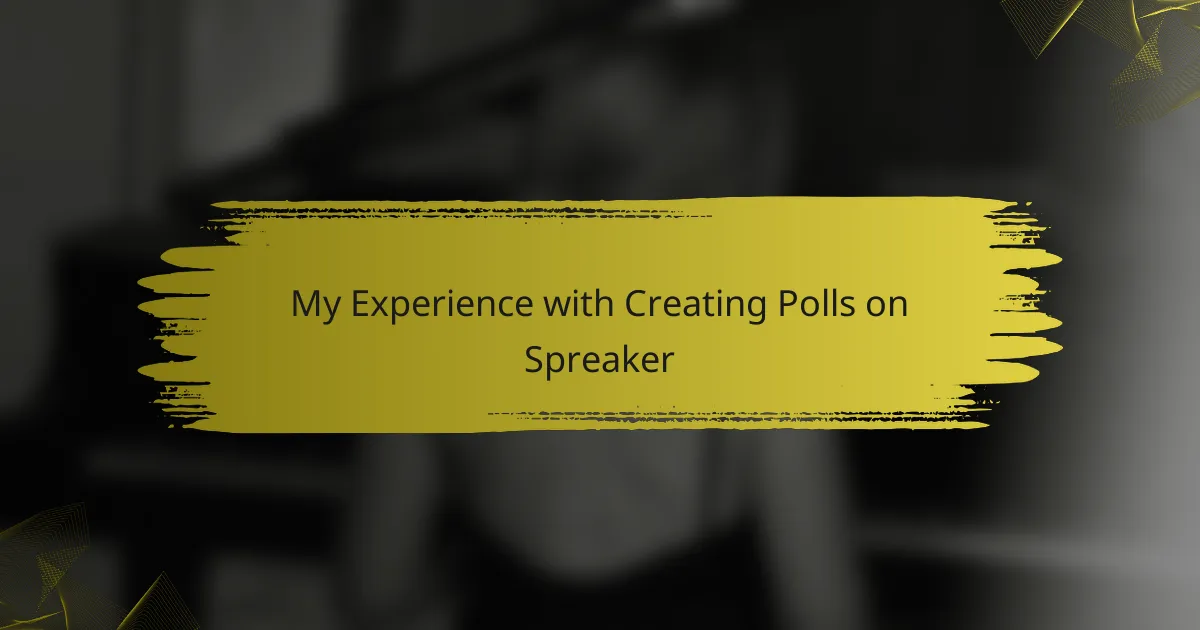Key takeaways
- Independent radio media allows for freedom of expression, direct listener engagement, and promotes underrepresented voices.
- Selecting the right podcasting platform influences the creative process, with options like Spreaker and Anchor catering to different needs.
- Creating polls enhances listener interaction, provides valuable feedback, and fosters a community-driven atmosphere.
- Analyzing poll results reveals audience preferences, guiding content creation to boost engagement and satisfaction.
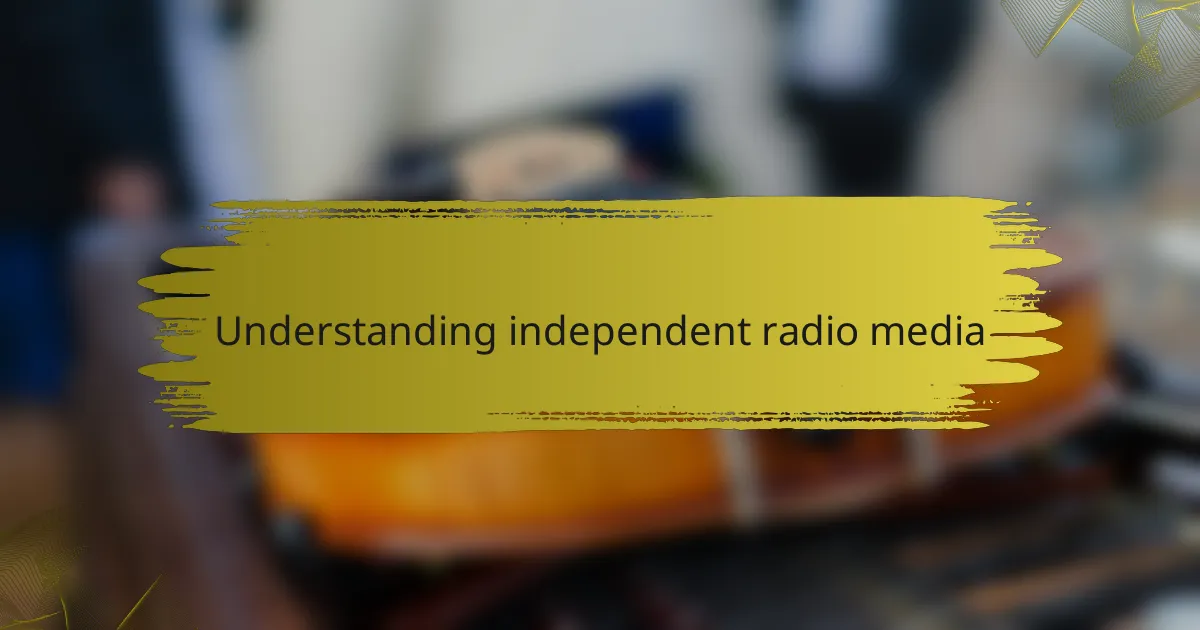
Understanding independent radio media
Independent radio media offers a unique platform for voices that might otherwise go unheard. From my experience, it thrives on creativity and community engagement, allowing hosts to connect deeply with their listeners. I remember the first time I crafted a poll for my audience; it felt exhilarating to invite them into the conversation.
The beauty of independent radio lies in its diversity and spontaneity. Unlike mainstream channels, these platforms often explore niche topics that resonate with specific communities. Here are some key aspects I find captivating about independent radio media:
- Freedom of expression without corporate constraints.
- Direct engagement with listeners through interactive features like polls.
- Opportunities to spotlight underrepresented voices and stories.
- Flexibility in content creation that adapts to audience feedback and trends.
- A sense of community, fostering loyal listeners who feel part of the process.
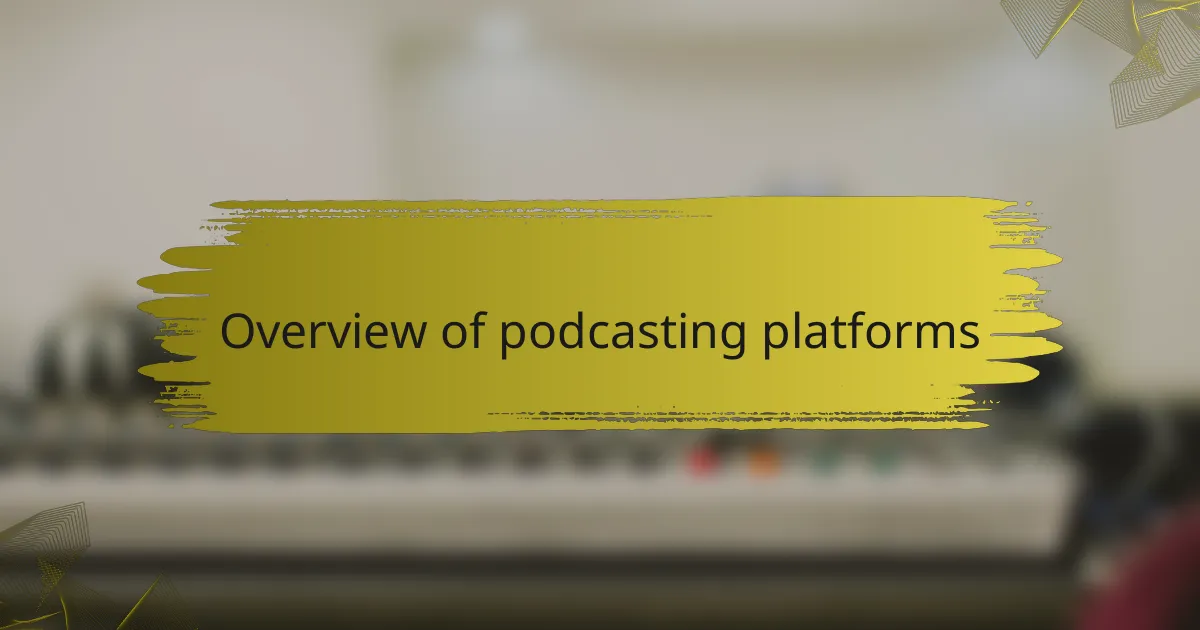
Overview of podcasting platforms
When I first ventured into podcasting, I quickly discovered that choosing the right platform can shape the entire experience. There’s a vast array of options available, each offering unique features tailored to different needs. For instance, while some platforms prioritize ease of use, others provide advanced analytics that can help you better understand your audience.
Reflecting on my journey, I remember the excitement and frustration I faced while testing various podcasting platforms. Ultimately, it was crucial for me to find one that struck a balance between functionality and accessibility. Here’s a selection of popular podcasting platforms that I’ve explored:
- Spreaker: Known for its user-friendly interface and robust analytics, which help you gauge your audience’s engagement.
- Anchor: Great for beginners, as it offers free hosting and easy distribution to major platforms.
- Libsyn: A pioneer in the podcasting world, providing extensive monetization options.
- Podbean: Offers an impressive range of themes and monetization possibilities, making it a favorite for many podcasters.
- Buzzsprout: Simplifies the process of getting your podcast live, with excellent customer support and resources.
Choosing the right podcasting platform profoundly influences the creative process, and I’ve learned what works best for my style along the way.
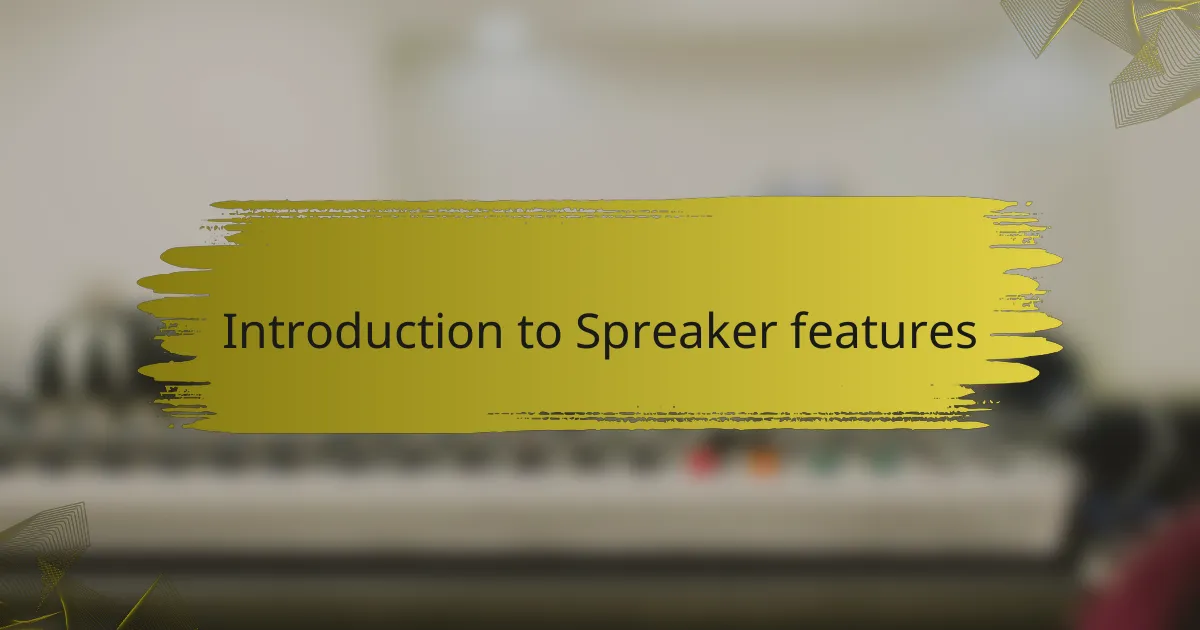
Introduction to Spreaker features
Spreaker stands out as a dynamic platform that empowers independent creators to share their voices effectively. One feature I appreciate is its integrated live broadcasting, which allows me to connect with listeners in real-time. I recall my first live session; the adrenaline rush was incredible as I interacted with listeners on the spot, making it feel like a true conversation rather than a one-way broadcast.
Another aspect that caught my attention is Spreaker’s analytics dashboard. It gives me insights into listener engagement, showing me which episodes resonate most. Reflecting on my initial stats, it was enlightening to see the power of audience feedback. Have you ever wondered how understanding your audience can shape the way you create content? I certainly have, and utilizing these analytics helps tailor my episodes to better fit what my audience craves.
Moreover, the ability to create and distribute polls seamlessly has been a game-changer for me. Spreaker’s user-friendly interface makes it easy to engage with my audience directly, inviting them into the decision-making process. I find that polls not only boost interaction but also give me a clearer sense of direction for future episodes, fostering a sense of community among my listeners.
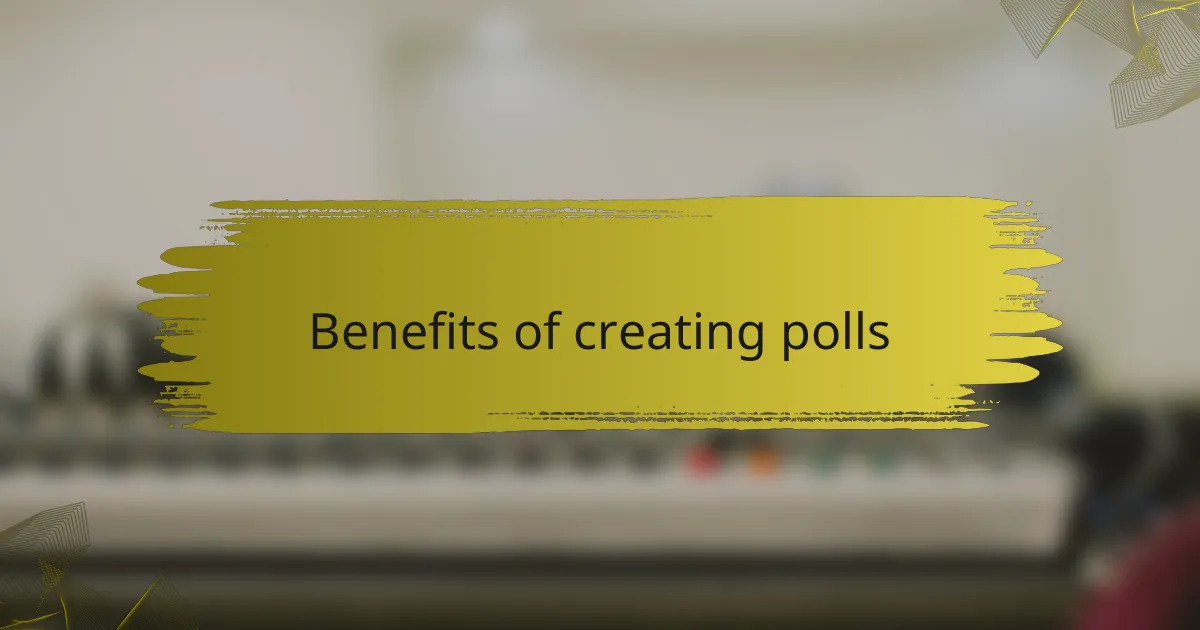
Benefits of creating polls
Creating polls on Spreaker offers numerous benefits that can significantly enrich your content and engage your audience. I’ve personally found that polls not only encourage listener interaction but also provide valuable insights into their preferences and opinions. For instance, when I first introduced a poll about the themes for my next episode, the response was overwhelmingly positive, sparking lively discussions and making listeners feel like they had a stake in the content.
The real magic, however, comes from the way polls can shape future content decisions. By directly asking my audience what they want to hear, I’m able to tailor my shows more effectively to meet their interests, which in turn boosts listener loyalty. This feedback loop has transformed my relationship with my audience, turning casual listeners into dedicated fans who feel connected to the content.
Here’s a comparison of the key benefits I’ve experienced while using polls:
| Benefit | Personal Experience |
|---|---|
| Enhanced Engagement | Listeners feel more involved and invested in the content, leading to lively discussions. |
| Valuable Feedback | Polls provide insights into audience preferences, helping shape future episodes effectively. |
| Stronger Community | Fosters a sense of belonging among listeners, turning them into loyal supporters. |

Step by step poll creation
Creating polls on Spreaker has been an insightful experience for me. I started by logging into my account and navigating to the ‘Polls’ section, where I found it surprisingly user-friendly. I crafted my questions carefully, aiming to engage listeners and spark meaningful conversations; I remember the excitement I felt when the first poll went live and feedback started pouring in.
In terms of the steps, I found that being straightforward and concise in my questions encouraged more participation. After drafting the poll, I double-checked that the options were clear and relevant. Finally, I hit the publish button, feeling a rush of anticipation about the responses.
Here’s a comparison of two methods for creating polls on Spreaker:
| Feature | Using Spreaker’s Poll Creation Tool |
|---|---|
| Ease of Use | User-friendly interface with guided steps |
| Engagement | Direct options to interact with listeners |
| Feedback Loop | Real-time feedback from audience responses |
| Customization | Limited to predefined templates |
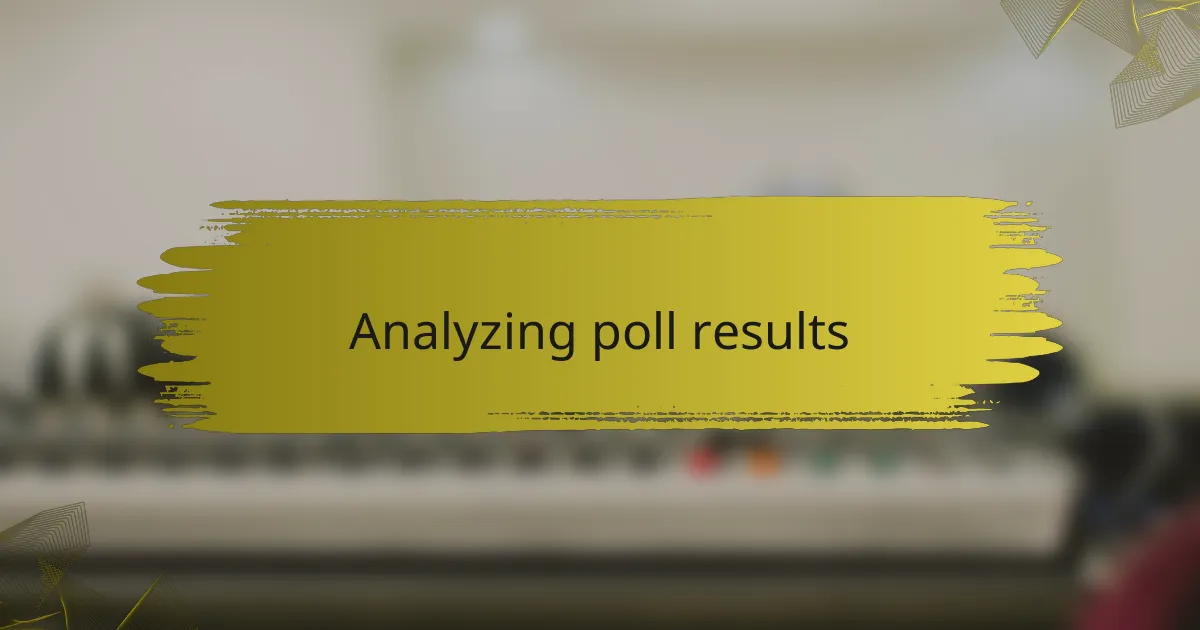
Analyzing poll results
Analyzing poll results can be both intriguing and enlightening. Based on my experience, the first thing I do is look for trends that emerge, such as which topics resonate most with my listeners. For instance, I once conducted a poll about the type of content my audience preferred—and the overwhelming response for interviews surprised me and significantly shaped my future episodes.
Another vital aspect of analysis is understanding the demographics of my respondents. By assessing who engaged with the poll, I can pinpoint specific interests or preferences among different listener groups. This has allowed me to tailor my content more effectively, leading to increased engagement and satisfaction. It’s truly rewarding to see how my audience’s preferences can steer the direction of my shows.
Here’s a simple comparison table to illustrate the difference between several types of feedback I’ve gathered through polls:
| Feedback Type | Impact on Content |
|---|---|
| Topic Preference | Directly shaped future episode themes |
| Guest Recommendations | Increased variety and listener interest |
| Format Suggestions | Improved overall listener experience |
